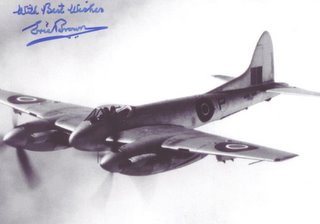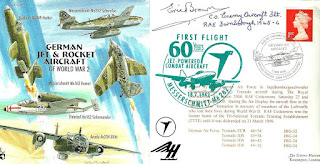Cpt (RN) Eric 'Winkle' M.Brown CBE,DSC,AFC 1919-2016
 Capt Eric M. Brown
Capt Eric M. Brown On December 3, 1945, Brown made the world's first landing of a jet aircraft on an aircraft carrier. He landed a de Havilland Sea Vampire on the Royal Navy carrier HMS Ocean.
On December 3, 1945, Brown made the world's first landing of a jet aircraft on an aircraft carrier. He landed a de Havilland Sea Vampire on the Royal Navy carrier HMS Ocean. ME-163 Komet as flown by Eric Brown
ME-163 Komet as flown by Eric Brown RAE Farnborough at the end of the war, with German captured and evaluated aircraft on display
RAE Farnborough at the end of the war, with German captured and evaluated aircraft on display

 DeHavilland Sea Hornet,one of Eric's favourite aircraft to fly.
DeHavilland Sea Hornet,one of Eric's favourite aircraft to fly. DeHavilland DH-108
DeHavilland DH-108Captain Eric "Winkle" Brown, CBE, DSC, AFC, FRAeS, RN is a former Royal Navy officer and test pilot who has flown more types of aircraft than anyone else in history. He is also the Fleet Air Arm’s most decorated pilot. He graduated from carrier-based fighter operations and deck-landing trials to test-flying at the Aeroplane & Armament Experimental Establishment at Boscombe Down in 1943, and became Aero Flight CO and Chief Naval Pilot at Royal Aircraft Establishment (RAE) Farnborough until 1949.
After World War II‚ Brown commanded Enemy Aircraft Flight, an elite group of pilots who test-flew captured German aircraft. That experience makes Brown one of the few men qualified to compare both Allied and Axis "warbirds" as they actually flew during the war. In late 1945 he led a British technical commission, which entailed evaluating and ferrying 55 types of German aircraft. Apart from new jet fighters and bombers such as the Arado Ar 234, Heinkel He 162, Messerschmitt Me 262 and Me 163, they included even more exotic aircraft, like the tandem-twin Dornier Do 335 and the prone-pilot Berlin B9 and Horten Ho IV tailless research glider. He helped interview many German scientists after World War II, including Werner Von Braun.
On December 3, 1945, Brown made the world's first landing of a jet aircraft on an aircraft carrier. He landed a de Havilland Sea Vampire on the Royal Navy carrier HMS Ocean. He holds the world record for the most carrier landings, 2,407.
In 1947, he was required to repeat the same flight profile in the second prototype D.H.108 tailless transonic research aircraft as that which caused Geoffrey de Havilland's death in the first prototype in September 1946. He survived after experiencing similar condition to that which caused the crash of the first prototype, succesfulling diagnosing what the problem was.
He was the designated pilot to fly the Miles M.52 aircraft, which when cancelled, was 92% ready to attempt to break the sound barrier.
He flew aircraft from Britain, America, Germany, Italy and Japan, and is listed in the Guinness Book of World Records as holding the record for flying the greatest number of different aircraft.
The official record is 487, but only includes basic types. For example Captain Brown flew several versions of the Spitfire and Seafire, and although these versions are very different they only appear once in the list.
He finally gave up his wings at 70 years old.

.jpg)

.jpg)



<< Home